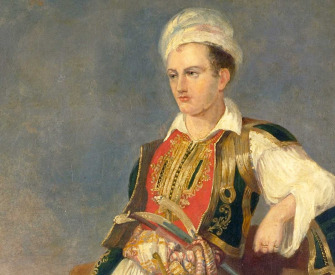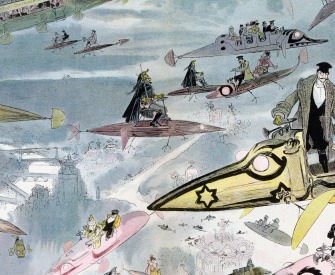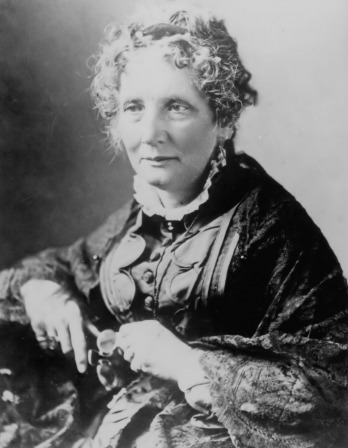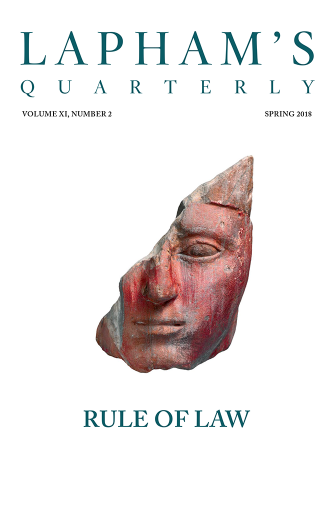An honest man is all right even if he’s an idiot…but a crook must have brains.
—Maxim Gorky, 1902A Fish Tale
Long before Moby Dick, Herman Melville set off on a Polynesian trip that became a famous literary hoax.
By David Samuels
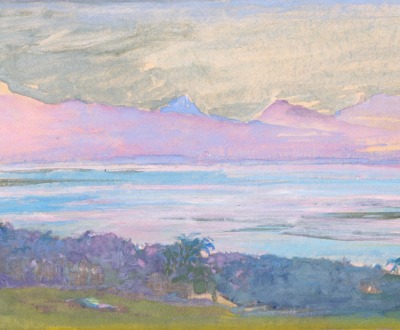
I can offer only the sketchiest explanations for how I came to occupy the top floor of a pleasantly wide banker’s brownstone in Brooklyn Heights, where the sun pours in through two high windows until midafternoon, glancing off the painted surface of the desk where I have lately been composing manuscripts on a little Olivetti manual typewriter. I purchased the typewriter on the street while in the company of my daughter, who shares my pleasure in beautiful old things that have survived the general shipwreck. Putting your grandmother’s stuff out on the sidewalk is the birthright of every American. We define ourselves in the present by forgetting the past, an auto-da-fé that illuminates the rituals of self-invention, which allows us to make ourselves up from scratch, or to sell chewing gum to the masses, or to move to California, the land of oranges and movie stars and a place my longtime companion Herman Melville imagined when he wrote the Gold Rush into his novel
Mardi.
Americans have always flitted back and forth between the present and whatever imagined future might dissolve outstanding complications and debts. Our penchant for self-invention has led to misunderstandings between Americans and nearly everyone else. But those who understand this driving quirk may admit that it is the source of much that is useful and particular, if also maddening.
I do my own arbitrage on the top floor of my house, which I rent together with my wife. The three floors below my sunlit aerie, which faces out toward the harbor, are noisily occupied by my older children—a son, age nine, and the aforementioned daughter, age five—according to a custody schedule approved by New York State family court. The aforementioned wife is also the mother of our infant son, Elijah, whose namesake is the prophetic old salt who warns Ishmael against boarding the Pequod in Melville’s Moby Dick. Our two Siberian cats, Herman and Melville, run up and down the stairs and wedge themselves behind the washer-dryer, until the creak of a floorboard sends them off like a shot onto the landing, with the sound of cat claws sliding and scraping on polished wood. When they get tired of these shenanigans, they will come curl up on my lap, which makes it devilishly difficult to work the Olivetti.
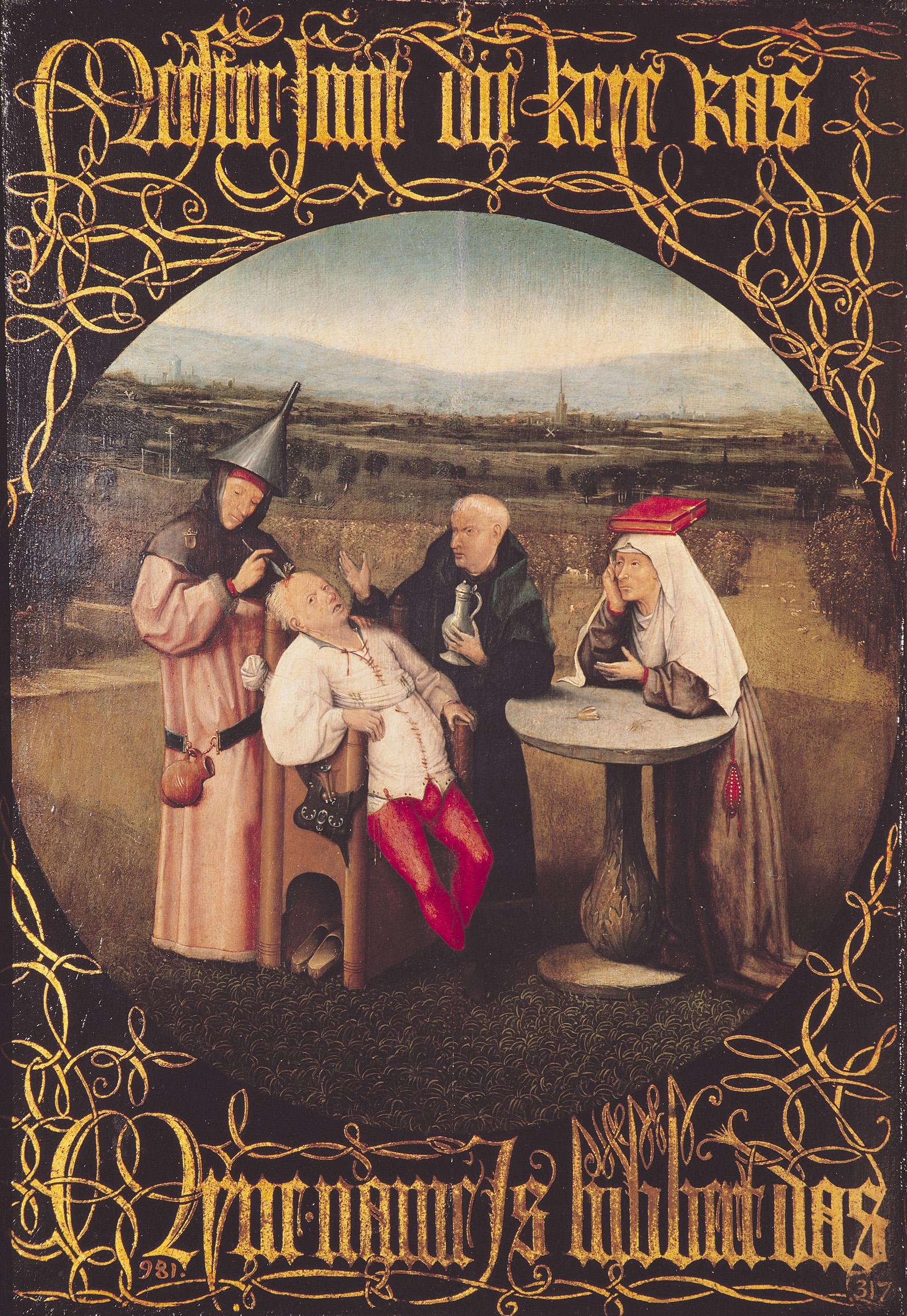
The Cure of Folly, by Hieronymus Bosch, c. 1480.
Having grown up not far from here, in a lower-middle-income housing project where the junkies left broken syringes at night in the sandbox, where I played among them the next morning, I can’t fault you for wondering how I pay for this whale of a house. Any honest man sans a private fortune will give you the same answer: I hustle, and play the angles, while keeping two steps ahead of the bill collector. At the end of the month, I take the kids to school in a cab and then I hunt for spare change in the cushions of my couch, until I gather a hoard that is sizable enough to exchange for a sandwich. The weight of the hustle is squarely on me, which is basically how nature intended it.
I tell my children that one of the defining pleasures of Brooklyn Heights is the morning view of the harbor. It is the prospect of Manhattan, figured as a ship heading out to sea in Moby Dick—the best description of the aforementioned view I have found—that impels Ishmael to try his luck on a whaler, which is the city in microcosm. The city, the country, our republican institutions, the capitalist system of industrial production, and the eternally tragic shape of man’s fate are written on the deck of the Pequod, just as Ishmael has a whale skeleton tattooed on his arm, leaving the rest of his skin as a blank parchment for a poem he has not yet written. I also own a whaler, a battered model boat whose name, inscribed in faded blue script on the side, is Acushnet—purchased on Martha’s Vineyard in a junk shop situated near the harbor of Menemsha, where fishing boats go out to sea and bookish types spend money in the summers. The ship, which I have sailed in the pond in Central Park, sits on a low modern table next to my daybed. When, like Ishmael, I yearn for adventure, or when I grow weary of carrying weight for a brood whose sole and incessant demand is that I return their love, I duck into the fourth-floor bathroom and float my sailboat in the bathtub.
W ho Herman Melville was and what he actually thought about anything are altogether unsatisfying questions that have never been answered in a satisfying way. This has led critics from the beginning of his literary existence to accuse him, often rightfully, of fraud. The proper answer to such criticism is that all literature is a species of fraud, in the same way that all property is theft, and every great fortune is founded on a great crime. As Cormac McCarthy once said, “The ugly fact is that books are made out of books.” The fact that McCarthy, author of Blood Meridian and other novels, stole the sentiment from William Hazlitt doesn’t make it any less true.
The fact that Moby Dick is the philosopher’s stone of American self-reflection makes it a wonderful target for reviewers, critics, and scholars who like to identify the books that Melville plundered, a good number of which are helpfully identified by the author in the novel’s prefatory extracts (supplied by a “Sub-Sub-Librarian”). “Give it up, Sub-Subs!” the author exhorts. But why should they? It’s fun to play games with whales and history. What they miss, of course, is that the fact that Melville’s literary career was born in fraud and realized its true greatness in the writing of Moby Dick is not a coincidence: Melville spent his entire writing life pondering the line that separates imposture from invention, and worse. Just as books are made of other books, every great American is a person who made themselves up out of whole cloth. So how else could a homespun American Shakespeare have happened, and what else could he have pondered, if not the frauds that define America and Americans?
Melville’s first book, Typee, the author’s account of his time among the Polynesians, made him famous; it was easily his most successful work during his lifetime. The new editor of the Brooklyn Daily Eagle, Walt Whitman, wrote an unsigned review pronouncing it to be “a strange, graceful, most readable book.” Whitman also noted a resemblance to contemporary seafaring tales, including an 1831 account of a shipwreck in the Caribbean Sea. Whitman’s nose for the magpie elements of Melville’s text wasn’t matched by two distinguished New England reviewers, who weren’t interested, or didn’t notice, or were too polite to say. In a signed review in the Salem Advertiser, Nathaniel Hawthorne, who had no personal taste for adventures, announced that the “book is lightly but vigorously written; and we are acquainted with no work that gives a freer and more effective picture of barbarian life.” Thoreau read Typee at Walden Pond, and appears to have understood the book as a valuable outline of experiments in living that had been successfully tested by Polynesian islanders.
To say that Typee is a book made out of other books doesn’t mean that Melville himself never sailed on the Acushnet, or that his account of his life among the Polynesians is devoid of truth in every detail. According to the surviving abstract of the ship’s log, ably summarized by Melville biographer Newton Arvin, the Acushnet, counting the twenty-one-year-old Herman Melville among its crew, headed for the Azores and Cape Verde Islands, then southward to cruise for whales, before it put in at Santa, on the coast of Peru. The ship then headed westward in the vicinity of the desolate Encantadas. After recruiting new men in the Sandwich Islands (the first and third mates, along with thirteen of the twenty-three-member crew, fled the ship or were put ashore with disease), the Acushnet sailed on to Nuku Hiva, one of the Marquesas, and dropped anchor in a bay called Taiohae, whereupon Melville fled into the interior along with a seventeen-year-old fellow seaman from upstate New York named Toby Greene. After a series of miserable days and nights, the two New Yorkers split up. Melville stayed behind with an infected leg, under the care of Polynesian natives, while Greene headed back to the coast for medical help.
As far as has been determined by generations of scholars, who have doubtlessly consulted every scrap of evidence available, Melville spent perhaps two to three weeks in the valley of Taipivai. He had never been to Polynesia before, and came equipped with perhaps a half-dozen words of the native language. Given his formidable powers of observation, and the limited observable routine of traditional Polynesian villagers, there is no reason to believe that Melville didn’t witness clothmaking and woodcarving. However, the scene in which his friend Kory-Kory rubs a six-foot pole between his hands, as his back arches and muscles tense, until it bursts into flame, is most likely a metaphoric rendering of a different act (no record exists attesting to whether Thoreau tried this method at Walden). The much-talked-about scene where the native beauty Fayaway drops her robe to reveal the glory of her nakedness at a discreet distance from the author is probably also a metaphor for something more earthy. There is plenty of evidence in surviving early manuscript pages to suggest that Melville originally wrote Typee as a familial in-joke, with members of his family cast as the natives.
Like most literary memoirs, at the time and since, Typee was obviously a fraud, in that very few of the incidents and quotations related could possibly be true. As Hershel Parker, biographer in the Melville business, put it: “If he admitted he knew only a handful of words in the Typee language, he complicated his narrative possibilities, since he could not plausibly introduce into the work anything he had not puzzled out on the basis of what he saw or what he was able to comprehend from the natives’ words and gestures.”
Melville was thereby caught in a dilemma that was broadly familiar to all journalists, in the days when journalism was a species of literature, and still fun to read: he could pretend to speak a language he didn’t speak, and become an outright liar, or he could admit his ignorance and entirely undercut his authority with his readers, in return for which he would be able to cite accepted works that didn’t contain his own insights. As Leon Howard so delicately puts it, Melville was forced to present “scenes and incidents…which he could describe in necessary detail only after research into the observations of others,” which included, in the published opinions of Melville scholars, Charles S. Stewart’s two-volume A Visit to the South Seas in the United States Ship Vincennes, During the Years 1829 and 1830, William Ellis’ multi-volume Polynesian Researches, and Captain David Porter’s account of his voyage on the Essex.
Typee was rejected by the editors of the Harpers publishing house, who scented fraud. Herman’s brother Gansevoort Melville took the manuscript to London, where he offered it to the publisher John Murray, who was dubious about the authenticity of the account, but liked the idea that an ordinary American seaman could write a literary account of his travels, thereby giving evidence of the salutary qualities of America’s democratic culture. He published the book, but then got cold feet, expressing grave doubts, which Gansevoort Melville relayed to his brother: “He tells me that the genuineness of the residence in the Marquesas is doubted, some thinking that it is an invention and not a narrative.”
Evert Duyckinck, one of the young journalistic standard-bearers of the American Whigs, and editor of Wiley and Putnam’s Library of American Books series that published Typee in America, also doubted that the events related in Melville’s book actually happened, but he enjoyed the book anyway. Reviewing Typee in the New York Morning News, he described Melville’s first-person narrator as “a good fellow among a club of good fellows whose sole infirmity was the occasional eating of human flesh” before proclaiming the author—whom he would later take under his wing, educating him about the darker workings of American politics and political economy—“this modern Crusoe.”
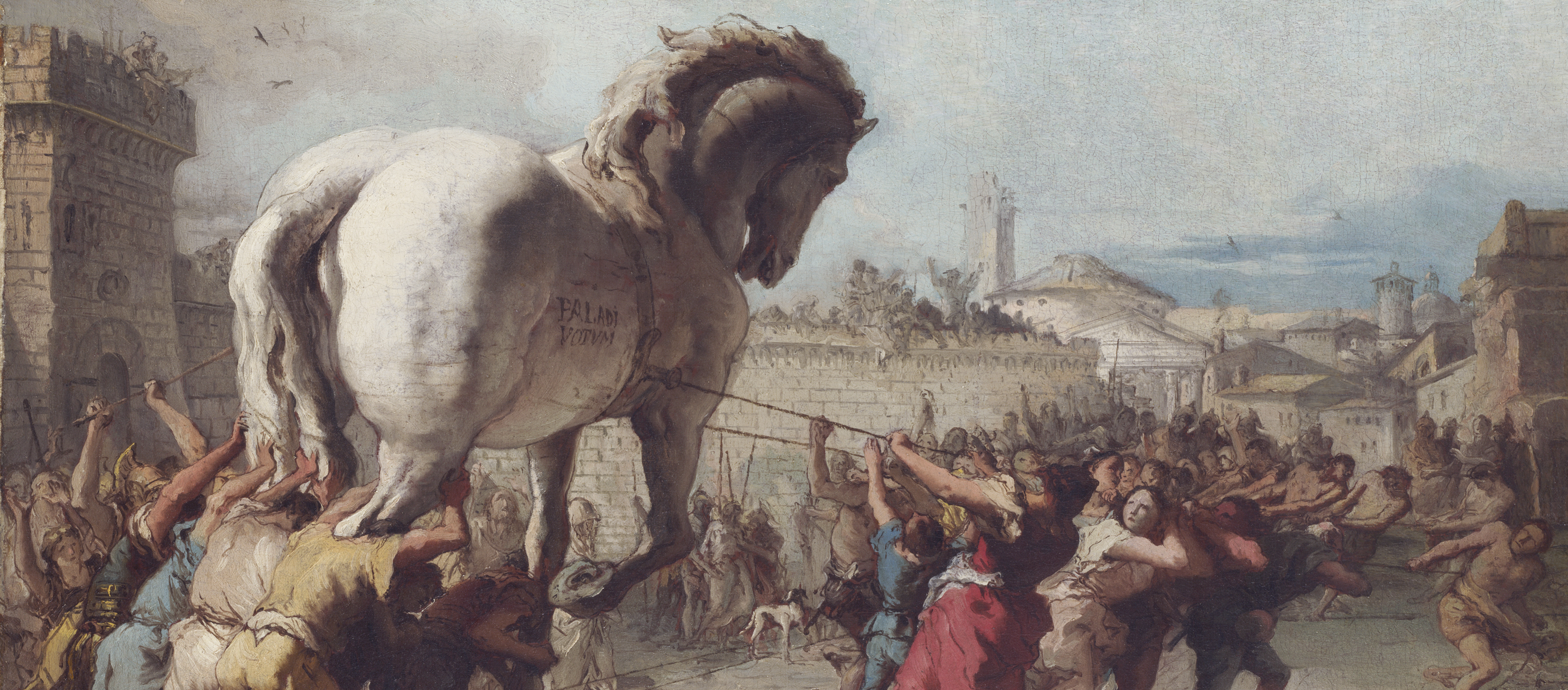
The Procession of the Trojan Horse into Troy, by Giovanni Domenico Tiepolo, c. 1760.
While Typee was first published to enormous acclaim in America, the doubts of Melville’s publishers were soon echoed by reviewers. After a review in the April 17, 1846, Morning Courier and New York Enquirer described Typee as a series of falsehoods “put forth as a simple record of actual experience” and dismissed it as “a piece of Münchausenism,” Melville began writing anonymous articles defending himself. It is easy to imagine that Melville’s literary career might have ended there, if not for the fortunate intervention of the Protestant press, which, incensed by his attacks on the conduct of missionaries in the Sandwich Islands, attacked the author for immorality, assuring Melville a flash of living immortality as the public face of licentiousness in 1840s America.
Supporters of American missionary societies were outraged by Melville’s suggestion that there might be anything un-Christian about their treatment of the natives, and that the natives didn’t dress like Park Avenue matrons, just as supporters of America’s expanding borders and trade routes bristled at suggestions that the sword’s edge of imperialism drew blood, or that sailors on merchant ships and U.S. Navy vessels were treated worse than dogs. “The enormities perpetrated in the South Seas upon some inoffensive islanders well-nigh pass belief,” Melville wrote to his brother, before he sat down to write Typee. “These things are seldom proclaimed at home, they happen at the very ends of the earth; they are done in a corner, and there are none to reveal them.”
Y et there is also evidence to suggest that Melville might have become a great writer even if success and controversy had not interceded and Typee had been thoroughly exposed as a work of fiction. The leading luminary of the New York literary scene of the 1840s was Edgar Allan Poe, an ex-newspaper reporter who caused a huge scandal in 1844 by publishing an entirely fictitious report of the voyage of an ostensibly famous European balloonist, Monck Mason, who was reported to have traveled across the Atlantic Ocean in only three days in the gas balloon Victoria, and to have landed at Sullivan’s Island near Charleston, South Carolina. (Monck Mason was a fictitious character. An unpowered balloon called Double Eagle II did finally fly across the Atlantic, in August 1978.) All was forgiven in 1845, however, when Poe forthrightly embraced the writing of fiction and published “The Raven” in the American Review in January, under the pen name “Quarles.”
The suggestion that Typee was a fraud stung Melville deeply. In his novels that came after Typee—including Omoo, Mardi, White-Jacket, and Redburn—Melville tried to write for a public that was outraged by the truth of what he saw and felt and whose appetite for hypocrisy had been whetted by the pleasing lies of Typee. Over time, the injury that Melville did to his own sense of truthfulness in pursuit of an audience exploded into a higher consciousness of fraud as the essence of literary art. Books are made of other books—and so Moby Dick flatly advertised its borrowings before the story properly began. Under the covering guise of fiction, both the author and his readers were released from the blatant hypocrisies of what their society was willing to accept and name as “real,” and so the fictional elements of the book needed to be heightened. And once he established the book as clearly a work of fiction, Melville could address the great white whale in its dual existence on the page as both symbol and whale, without having to answer anyone’s questions about the exact length of the whale or its precise coloration, or whether or not Herman Melville was actually on the boat. The more theatrical the plot, the more Shakespearean the language, the more heightened the story elements of his tale, the truer it was to fiction, the better it served as a mirror to Melville’s own truth. Through these acts of art, Melville created a space in which his readers could suspend their disbelief. He then filled that space with everything he knew and felt to be true about the ineffable fates of humans and whales.
Children and fools cannot lie.
—John Heywood, 1546Melville had been thinking about writing something like Moby Dick from the very beginning of his literary life. Before he set off to Liverpool, on his first voyage, he may have read the account of J. N. Reynolds in the Knickerbocker Magazine of “an old bull whale, of prodigious size and strength” who was “white as wool” and bore the names “Mocha Dick” and “the White Whale of the Pacific,” and of the numerous boats “shattered by his immense flukes, or ground to pieces in the crush of his powerful jaws.”
In the section of his notes for the manuscript Moby Dick titled “What I Know of Owen Chace &c.” Melville recalled having met the sixteen-year-old son of the celebrated author of the Narrative of the Most Extraordinary and Distressing Shipwreck of the Whale-Ship Essex, of Nantucket; Which Was Attacked and Finally Destroyed by a Large Spermaceti-Whale, published in 1821. “I questioned him concerning his father’s adventure; and when I left the ship to return again the next morning,” Melville wrote, “he went to his chest and handed me a complete copy…of the Narrative.” He added that “the reading of this wondrous story upon the landless sea, and close to the very latitude of the shipwreck had a surprising effect upon me,” a statement whose truth can perhaps be measured by the density of Melville’s annotations in the margins of his copy of Chase’s memoir.
The difference between Typee and Moby Dick is not that the first story was true and the second was not; they were both stories, ginned up out of facts and stories drawn from other books, as well as stories Melville had been told, or things he had seen or experienced firsthand. The difference is that Moby Dick was an entirely self-aware lie of the author’s mind, which he used to deliberate literary effect.
Between August 1850 and August 1851, Melville wrote most of Moby Dick. It is possible to imagine Melville at the end of this year in the character of Ahab when he is first introduced to the reader: “He looked like a man cut away from the stake, when the fire has overrunningly wasted all the limbs without consuming them, or taking away one particle from their compacted aged robustness.” In this interpretation, Melville drove himself mad to write his masterwork, his own singular genius serving in the role of the great white whale, as “he pitted himself, all mutilated, against it.”
The single move that unlocked the genius of Melville’s storytelling and characterization and love of language and magpie habits in Moby Dick is his decision to create a dialogue with his readers through the character of Ishmael, who is not Herman Melville, but who serves as substitute for the character of “I,” which allowed Melville to remain puzzlingly and frustratingly absent from all of his earlier work, and at the same time obliged him to insist on the literal reality of his adventures, which in the end are more or less like other people’s adventures.
“Call me Ishmael” is a command issued to a reader whose only two choices are to submit to the author or stop reading his book; it is the equivalent of walking into a casino and betting all your money on a single number at roulette. Most of all, it gave voice to Melville’s deepest authorial desire, which was to be present and absent at the same time, to hide in plain sight while using his extraordinary love and feel for the sounds of words and for the human condition, which is tragic, in combination with his love of books.
When Melville’s cetologist says “I have swam through libraries and sailed through oceans,” it is again clear that the place books come from is other books. In addition to The Lusiads of Luís de Camões and the plays and poetry of William Shakespeare, Moby Dick was descended from Henry T. Cheever’s The Whale and His Captors; Thomas Beale’s Natural History of the Sperm Whale; William Scoresby’s Journal of a Voyage to the Northern Whale Fishery; and J. Ross Browne’s Etchings of a Whaling Cruise. Yet the literary genius of Melville’s book has nothing to do with the genre of whale stories, which, as this catalog of course material shows, was commonplace. (I once paid twenty dollars for an old whaling novel from the 1840s in a bookstore near Melville’s old house in Greenwich Village, but I lost it in one of the many moves that preceded my happy arrival in my brownstone.)
The book that Moby Dick owed the most to was in fact Typee. If Ishmael is Melville’s true narrative self, a half-empty garment, loosely inhabited, yet exerting a power over the reader that is nearly absolute, Typee is present in the form of Queequeg, Ishmael’s pagan bedmate. Where Kory-Kory rubbed his six-foot stick to make fire, Queequeg sleeps next to Ishmael, his harpoon at the ready.
Typee was a fraudulent pastiche, because the first-person “I” who tells the tale is named Herman Melville, a decision that traps the narrative in the straitjacket of an authorial lie that the author was not yet aware enough to escape from. But
Queequeg is gloriously alive—because he has a big harpoon, and because the mirror in which we see his face reflected is held up by Ishmael, who reflects Melville’s own true book-mad self. In becoming Ishmael, Melville freed himself to reject the mad doctrine of authentic experience that had been the foundation of his reputation as the “modern Crusoe” but which he knew was crap, and which he rejects in the plot but not in the telling of Typee. We can perhaps glimpse Melville’s reaction to finding an honest voice in Moby Dick: after all, it is the idea of finding his authentic true self in nature that drives Ahab mad. When Starbuck objects that “to be enraged with a dumb thing, Captain Ahab, seems blasphemous,” Ahab replies, “All visible objects, man, are but as pasteboard masks.” He then exhorts:
Strike through the mask! How can the prisoner reach outside except by thrusting through the wall? To me, the white whale is that wall, shoved near to me. Sometimes I think there’s naught beyond. But ’tis enough. He tasks me; he heaps me; I see in him outrageous strength, with an inscrutable malice sinewing it. That inscrutable thing is what I chiefly hate; and be the white whale agent, or be the white whale principal, I will wreak that hate upon him.
The white whale is the limit that Ahab will not accept: “The indefiniteness it shadows forth the heartless voids and immensities of the universe, and thus stabs us from behind with the thought of annihilation.” As they approach the whale, Ahab recovers his humanity enough to glimpse his wife and child in Starbuck’s eye. “Close! Stand close to me, Starbuck; let me look into a human eye,” he demands, “it is better than to gaze into sea or sky; better than to gaze upon God.” Ahab understands that he is bound to the choices that have shaped his fate. But he keeps pushing on. He is deaf to Starbuck’s desperate, final plea, in which he fails to recognize either himself or his foe: “See! Moby Dick seeks thee not. It is thou, thou, that madly seekest him!”
Moby Dick is a tragedy, which is a genre that Americans, animated by our faith in the idea that we may be endlessly reborn from our own self-conceptions like Athena from the head of Zeus, are seldom able to apprehend. The ghost of the Puritan inheritance that shadows the American Dream is invisible to us, at least during daylight hours. To believe in tragedy means to believe in circumstances where even the mightiest human efforts are foredoomed to failure. Even as he approaches his certain end, Ahab cannot finally perceive his life as tragic; instead, he imagines his wife at home telling his son “of me, of cannibal old me, how I am abroad upon the deep, but will yet come back to dance him again.” He imagines he is loved by his wife and son, even as he is finally consumed by his binding hatred for the whale. Unlike Hector, who knows with absolute certainty he will be slain by Achilles outside the gates of Troy, Ahab’s American faith in self-determination blinds him to the fact that his quest can only end badly. The inexorable nature of Ahab’s fate, which springs from his inability to see himself, and thereby understand the nature of his own choices, is what makes Moby Dick that rarest and most awe-inspiring of works, a tragedy that Americans have come to recognize as their own.
Moby Dick, like all great books, was born in fraud, but it became something new through the alchemy of self-awareness. It escaped the fate of lesser books, Melville’s prior works included, because its author was able to so clearly recognize himself in the mirror he had fashioned out of what he borrowed and stole. Melville aligns himself not with Ahab but with Ishmael, the sole survivor of the shipwreck. Ishmael is saved because he is the embodiment of the delicate line of the author’s self-awareness; he alone is able to bear intimate witness both to Ahab’s madness and the dance of the mother whales and their children swimming together beneath the spears of the hunters, connected to each other by a living umbilical cord that is tangled with a hempen one.
Melville’s awareness that his life-giving art could never be disentangled from the indelicate fraud of appearances that is an inevitable and necessary part of artistic creation would become the theme of his next novel,
The Confidence Man , in which he anatomized and catalogued the species of riverboat hucksters, originating the idea of the con artist as the defining American type. From both the emotional-historical-philosophical and the purely literary point of view, Melville’s idea of what defined America and Americans—their self-invention, their hustles, their confidence—was a radical improvement on the view of America posed by James Fenimore Cooper, who looked to the American encounter with the primeval forest and the natives who lived there. Fenimore Cooper wasn’t wrong, of course. It’s just that by the time America was really born, he was already out of date and Americans had already started in on the national project of self-invention, in which we bootstrap ourselves, generation after generation, into the limitless future that is the birthright of every native son who is promised life, liberty, and the pursuit of happiness.
